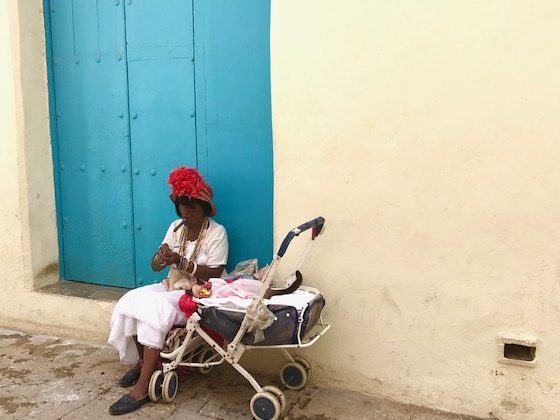
This is a Sponsored Post for Fathom Cruise. However, all opinions about Santeria are my own.
I had the opportunity to travel to Cuba through Fathom.org a few months ago, and it was amazing! I’ve always loved the Cuban lifestyle, specifically the food, haha! I lived in Miami Beach for ten years and got to know the culture and made many Cuban friends.
During my visit, I quickly learned their language in Spanglish so I could sell cosmetics to the shoppers at Downtown Macy’s. Also, I drank coladas daily and enjoyed the amazing cuisine at David’s on Miami Beach, which closed after many years.
The depth and width of Yoruba belief and yoruba deities and their practice on the island was one of the most fascinating surprises of my journey. According to anecdotal evidence, more than 80% of the Cuban population are either worshippers of several Yoruba Orishas or a Santeria believers.

5 Things You May Not Know About Santeria
Because I got to know Cuban people so well living in Miami, I quickly learned that most Cubans were very religious, have their own belief system and spiritual traditions.
I never really asked my friends but noticed that many of them were praying to what I thought were saints. Sometimes they wore white clothes on certain days, adorned with beads around their necks. I never wanted to pry and I’m glad I didn’t.
But I always wondered what Santeria’s belief was and if it was voodoo, along with animal sacrifices, like many people said.
So, when I went on my Fathom cruise to Cuba, they offered a class on the history of Santería in Cuba. Hence, I learned that Santeria plays such a huge part in Cuban culture.
There are five things I didn’t know before I took this interesting class on the Adonia Cruise Ship!
1. Santeria is a Religion.
Yes, it’s a religion. It was even taught as a class at FIU when I attended there. And today it is one of the syncretic religions.
Santeria, also known as La Regla Lucumi or the Rule of Osha, is an Afro-Caribbean religion based on Yoruba traditions and Roman Catholicism. Today, national origin determines variations in practice.
Santeria arose among Afro-Cuban communities following the 16th to 19th centuries Atlantic slave trade. It evolved from the blending of traditional West African religions brought to Cuba by enslaved West Africans, the majority of whom were Yoruba, and Roman Catholicism. Cuba is still the religious center of Santería, but the faith has spread to many other countries as well, like Puerto Rico. Many Latin Americas now a days believe in santeria.
During the late nineteenth century, these traditions merged with Spiritist ideas along with Catholicism in urban areas of West Cuba to form the first casas.
Santeria has no scriptures. Hence, believers pass it down through oral tradition. But there are few structures dedicated to worship. Also, believers frequently held rituals in rented halls or private homes. At these sacred sites, the Orishas meet believers during ritual.
Interestingly, there is a Santeria church of Lukumi Babalu Aye in a city of Hialeah in Florida. The church practices Cuba’s Santería or Lucumí tradition / Regla de Ocha.
2. Initiation is a Big Part of Santeria.
Initiation is not done for power or money because its purpose is for moving forward in life. There are also different levels of initiation and that’s where the necklaces come into place.
Sometimes they go through full Initiation as a Santero Priest (high priest) or Santera Priestess. They are spiritual leaders and represent the Orishas.
There are other initiations like becoming a Babalawo which means Father of the Secrets. The process of initiation is a huge part of the religion. After it, one becomes family member of an extended family, having Godparents.

3. Santeria in Cuba has many Deities.
People refer to God as Oloran, the “owner of heaven” and the creator of the Orishas. There are around 1700 Orishas, male and female who are the servants of Oloran. There are Orishas of virtually everything.
One of them is goddess of the sea, Yemaya, also called the mother goddess. She is ruler of the home, fertility, love, and family.
Oshun is the goddess of love, beauty, prosperity. She forms balance with Yamaya because she is also the source of fresh waters.
Each Orisha has a sacred number, color, and a blending with a Roman Catholic Saint. For instance, Saint Anthony is the equivalent to Santeria’s Orisha Ellegua. The colors are red and black and the numbers are 3 and 21. Ellegua is also known as a mischievous child.
In the Afro-Cuban religion of Santeria, people assimilate Santa Barbara to Chango, the deity of fire, thunder, and lightning. Cuban tradition advices people to offer to her apples, roses, cigars, and rum.
4. Practice of Animal Sacrifice.
Ebo means “offering.” People treat the Orisha like a human being and give it food. It’s a common sacrife for Santerians. Sometimes it is fruit, cooked food, and sometimes it’s blood. Animal sacrifice, or Eyebale, usually takes place in rented space or private homes.
According to Santeriachurch.org, “Animal sacrifice is something that should be done with great respect to the animal, making sure they are given plenty of food and water as well as room to move about while in holding prior to the ritual.”
The sacrifice method in Santeria involves the severing of the carotid arteries with a knife to cause the animal to pass out before it dies. Hence, this humane way of killing an animal is identical to the way animals are handled with Kosher and Halal religious slaughter techniques.
Usually, after the initiations, women cook the meat of the sacrificed animals and share with the community. So, the orishas drink the blood, and the people eat the meat. Hence, it is an act of communion with the spirits. Believers told me that without this sacrifice the religion would die out.
5. There’s a Street in Cuba Dedicated to Santeria called Callejon de Hamel
The Fathom cruise offers excursions and one of them is to visit Callejon de Hamel street! It is a magnificent street full of authentic art!



This street is a dedication to Afro-Cuban culture where you will see all types of street art and colorful murals!
This place is a street artist’s wonderland! And I assure you that I really felt like I stepped into a psychedelic mural where the art comes to life.
It is also home to the artist and Cuban painter Salvador Gonzalez Escalona. His work is a mix of surrealism, cubism, and abstract art.
There is an art shop where you can purchase his paintings at Callejón de Hamel! We met him inside his gallery and saw some of his work. He has many students that work with him and they also sell their art.
This guy is someone you will see a lot in the heart of Cuba!

His name is Elias. He is the head assistant who gave us a tour of the street. Oh yes, I’m telling you he pretty much smoked that cigar the whole time, lol.
Also, Saturdays are a popular day to visit this street because there are Rumba parties. And yes, there is a nice bar there which you must visit! I already miss my trip because I enjoyed it so much!

6. Healthcare
Santería priests priests are well-versed in ancient medicine and herbalism, and they frequently play a major role in the community’s health. A Santerian priest is often called a medical doctor and Santeria healthcare is often combined with conventional medicine.
Finally, If you decide to take a trip to Cuba, I highly recommend that you check out this area and spend time learning about this amazing culture and the Santeria belief! And surely don’t forget the Sunday rumba party at Callejón de Hamel! There are so many things to do in Cuba!












